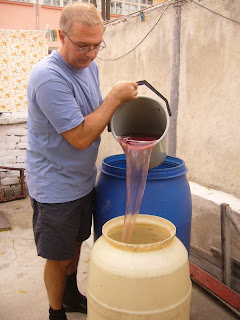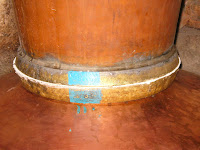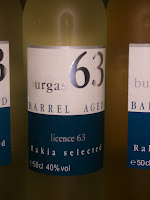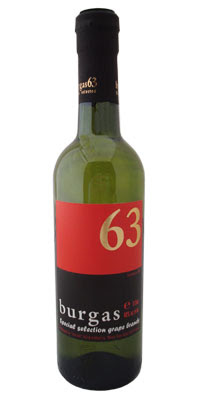
Monday 20th October was the day that the yearly Rakia making was to take place. Galia my Bulgarian partner had reserved the still with a 5 leva deposit as the Rakia House was only across the road from where she works.

The price is still 15 leva for the session as it has been for the past two years based on my using the smaller sized still. I only had some 300 litres of fermented grape juice to process; it was an extra 5 leva for the bigger stills that can take up to 500 litres of wine mixture each time.
The grape mixture had been fermenting for around month with now just a thin layer of grape seeds floating on the top and clear red wine seen underneath, this was now ready to distil. There had been 30 kg of sugar and 90 litres of water added to the grapes to give it extra alcohol content, the higher the alcohol content in the wine, the more in the rakia. There was additional alcohol to be added as I had some 10 litres of tail end Rakia that was made from last year that only reached around 25% proof and about 4 litres of homemade wine which no one had time to drink. These were to be added to the mixture that was to be distilled.

The evening before, we borrowed a van to take the wood from the Skalitsa farmhouse and the wine from the Yambol house to the Rakia house. The reason for this in advance was quite simple. The still had been booked for 6:00 in the morning. Firstly it would be dark and secondly, I was to be on my own and shifting near on half a ton of liquid would be too much.
The things you have to remember are many on the Rakia Making Day. I am not normally a list making person but thids was done as quite a few things were forgotten last time around.
· The Wine (In Barrel(s))
· Any other low alcohol content Rakia from last year or wine to be added to the Still
· A Bucket (To Collect the Rakia from the still)
· Funnel
· 3 x 10 Litre Plastic Bottles (for Rakia to be stored)$
· An Alcohol Reading Glass
· Jar or plastic bottle (for Rakia samples to be measured for Alcohol content)
· Food for the Barbecue and Drink (Beer)
· Wood
· Flour (for sealing the still)
· Cardboard and tinder
· Matches or Lighter
· Soda
· Salt
· Other Secret Ingredients
All the above was prepared the night before and loaded in the Lada and after a 5:00 alarm call; I set off at 5:45 on a cold, dark Yambol but fresh Yambol morning.

I arrived and set about finding the still that I was to use. There were ten active stills in this particular Rakia House including on that had a double distilling facility and actually quite a work of art. Every single still were either still blazing away with a fire or currently being used by people, mine was still smouldering in the furnace.

There is a non-stop system here for around two months, 24/7 as the demand from mid September to mid November is at its peak. There is a husband and wife team who live on site (in a lovely house and garden joining the Rakia Work Room). They work all hours during this peak period.

My still had to be dismantled, cleaned out and resealed after being filled with the grape mixture before the process of distilling can start. The is a person employed to do this as he set about setting up my still; this is part of what we pay for of course. Because my Bulgarian is much better this year, I was able to take more in and listen with more understanding with people I spoke to over the next five hours. Another giant step in the Rakia making learning curve was made today as I was now loading all the Rakia mixture into the brass still. Little trick on how to do this with the least amount of energy was given as the whole load had now been transferred much easier into the still than putting it into the van last night.
Flour was put around the seal of the bottom of the still and the big top bowl placed on top and wriggled into place to form a non-breaching seal that would harden with the heat that was to be applied.
It was now time to get the smouldering fire back to full power as cardboard, tinder and smaller pieces of wood were thrown on the furnace.


There is a big metal door that is used a a ventilation regulator, this is taken away for the draft to come in forcing the smoulder into a raging fire within minutes. The door is put back and the wait is now on.
With constant topping up of wood to keep the fire ranging it was a full two hours before the first drop of Rakia was seen to dribble out of the pip a the end of the process. During this wait however I took time to talk and ask questions about what I saw. there were many people more than willing to give away some secrets and other who didn't. One couple brought in a bag of hard-boiled sweets and started unwrapping them. I asked why as they continued to unwrap them. This was to be put into the wine mixture as they said that the sweetness would make the kissing much sweeter after drinking this particular Rakia. Lovely sentiment I thought.


There was much to see here as I looked more closely at the double distilling system. It had two cooling processes with the main still being subjected to great pressures to force the steam through the first system; it even had a pressure gauge. Then through the second cooling process this was like the others it the room but a double system of trickling Rakia out of this was artist as well as practical giving it more opportunity to cool further before being bottled.
Next to the double distilling system was another curiosity as I saw a cloth tied tot he end of the pipe outlet. Asking about it, it was simply put there so the fresh Rakia is sent through a barrier of herbs a kind of pot puree which is then added to the Rakia once bottled. It is said to give the Rakia a perfume and flavour. He would not tell me what was in his herb mix though, understandably.

The grape pomace that is left after distilling is flushed with water down a gully outside and then given to the many pigs that are to be fatten for the December and January slaughtering. This is the beauty of recycling; there is absolutely no waste involved here at all.
There were not only furnaces burning away for the Rakia but as always in Bulgaria, they were used as barbecues by most with bread turned to toast with many different meat based salami following up closely. they tasted great with the beer that was being used to wash it down. Don't forget, I start here at 6:00 and beers were being drunk at that time! Very unusual for me to drink this early but both the barbecued food and drink when down a treat in this house. The heat from the ten furnaces just add to the relief you get from a cold Bulgarian beer

It was also noticed that I was the only party that had come here on his own. Every other party had come with a friend or family, but then most here took time off work to do this. Many of their bosses' fully understand the need to make Rakia in Bulgaria and will be more than accommodating to give time off, and no doubt get some Rakia in return.
Many wives were there, they carried the wood, cleaned up after the men and attend mothers' meetings when they got a chance.

Quite a few were tasting the Rakia fresh from the tap, in fact quite surprisingly far more tasting of Rakia went on by the women than the men. The men however were more obsessed with the regular checking of the alcohol content in fact this went on every ten minutes of so. I myself got into that habit as well as it is needed in the later part of the process.

There is nothing like seeing the first trickle of Rakia plopped into the bucket. It is as that point that you know where the work put in before was worth the effort. There is always a lingering feeling that not being Bulgarian, the Rakia I make will be inferior to the native folks' Rakia. the testing was now on for the first sample.

A small jar was taken and filled then the glass alcohol-measuring tool was gently place in to settle. The reading was just over 70% proof, a warm glow of satisfaction was felt as this was read, as around everyone else there wanted to know how the Englishman's Rakia faired. Well they were told and a few pats on the back were felt as it was circulated.
As the distilling progressed I had gathered around 30 litres of Rakia with constant measuring of the alcohol content. Each time the percent dropped, I was told that directly it hit less that 40% the gathering of the Rakia was to be put into another container and used in next year wine mixture. I did exactly that an ended up with another 10 litres beyond the drinkable Rakia to carry over.
With all the Rakia extracted the 30 litre of drinking Rakia was measured for alcohol content. It measures a good solid 50% proof and I was very happy with that indeed. I may even consider added mineral water to this to bring it down to 45%. I will decide that at the end of November after it is ready to drink.
Still more things were being added to others' finished Rakia around me and much more will happen when the Rakia is taken to the homes of the distilled Rakia and done without peering eyes giving away the family secrets. I was no expectation as
Dino my Skalitsa neighbour gave me his secret before he went off last year to make Rakia for the Angels above. It is now secret that a certain type of wood is added tot he Rakia to give a darker amber colour and already I could see Rakia less than an hour old showing signs of darkening where the wood had already joined the drinking party in the Rakia stored bottles. Mine will have to wait until the weekend as the wood is in the woods near Skalitsa and will have to be cropped.

The car all loaded, 'thank you' said to many that gave advice and help and it was back home along the bumpy Yambol roads. These drives are well used to now for someone who travel on them on a daily basis, but today, slightly more nervy as the carefully driven Lada makes sure that the Rakia filled barrel didn't topple en route.
Back at the Yambol house, it is 12:00 and the Rakia was now in safe storage in the garage. The whole process taking around 5 hours was something I really enjoyed. As I went to pick Galia up in the evening the Lada had a smell of Rakia that will last a few days. This is a very pleasant smell but we just hoped the police don’t stop me as it may arouse suspicions, or maybe they know this smell in Ladas is normal here this time of year.
More about the Rakia Distilling Process can be found here
The-Rakia-Making-Process
 http://bulgarianslivatree.com
http://365bulgarianadvetures.com
http://bulgariantruelove.diydating.com
http://doshforu.com
http://bulgarianslivatree.com
http://365bulgarianadvetures.com
http://bulgariantruelove.diydating.com
http://doshforu.com
 Rakia colour (USA color), how is it achieved? Why do Bulgarians do it? The thousands upon thousand of litres of Rakia that is distilled in Bulgaria comes out with no colour at all, it is crystal clear. So the colour that Rakia is normally associated with is another process, another tradition and another fascinating process that takes place through natural resources.
Rakia colour (USA color), how is it achieved? Why do Bulgarians do it? The thousands upon thousand of litres of Rakia that is distilled in Bulgaria comes out with no colour at all, it is crystal clear. So the colour that Rakia is normally associated with is another process, another tradition and another fascinating process that takes place through natural resources. To most home made Rakia it is s simple process of taking some mulberry wood, splitting it up into short sticks and placing a few in the rakia while it is in bulk storage fo around the initial six weeks. Depending on the variety of mulberry, the number of sticks and the length of time in the Rakia will determine how light or dark the Rakia will be. There is close to clear Rakia in the commercial market but the vast majority of Bulgarian home Rakia distillers opt for some form of darkening the spirit, most with the mulberry method.
To most home made Rakia it is s simple process of taking some mulberry wood, splitting it up into short sticks and placing a few in the rakia while it is in bulk storage fo around the initial six weeks. Depending on the variety of mulberry, the number of sticks and the length of time in the Rakia will determine how light or dark the Rakia will be. There is close to clear Rakia in the commercial market but the vast majority of Bulgarian home Rakia distillers opt for some form of darkening the spirit, most with the mulberry method. It is a fact that the different shades of Rakia colour are just as different in each Rakia as in the taste and people would also have a tendency to favour either the lighter or darker Rakia and make their own accordingly.
It is a fact that the different shades of Rakia colour are just as different in each Rakia as in the taste and people would also have a tendency to favour either the lighter or darker Rakia and make their own accordingly.




















![Reblog this post [with Zemanta]](http://img.zemanta.com/reblog_b.png?x-id=fb9b17ed-760c-4ad2-8ce7-1b859ff58ad9)












